Making the case for global growth: Why localization and personalization are business essentials
As companies across every sector pursue international expansion, the need to connect with customers in their own language—and on their own terms—has never been more urgent.
According to our 2025 Global Business Case for Expansion study, 90% of businesses are planning to enter new markets with different languages within the next five years, yet over half say they’ve already lost business due to a lack of proper localization. In fact, 87% confirm that investing in translation and localization has directly contributed to successful expansion efforts.
This guide brings together essential data to help marketing, operations, localization, and technology leaders build a powerful business case for investment.
Whether you’re launching in Asia-Pacific, refining your presence in Europe, expanding operations in the US or the UK, or tailoring customer experiences in the ecommerce, gaming, tech, manufacturing, travel, or automotive space, these sector–and region–specific insights are designed to support smarter decisions, stronger engagement, and sustainable global growth.
You can view the full collection of global-level statistics on this page, or download a specific regional or sector-based version of the guide directly below.
United States: Bridging language gaps to unlock global growth
In the United States, ambition to scale internationally is high—97% of businesses plan to expand into new-language markets within five years. But the road isn’t easy.
A staggering 81% of U.S. companies have already lost business due to inadequate localization strategies, while 75% struggle to adapt products and maintain brand consistency across borders.
This guide reveals why nearly all U.S. business leaders now view translation and localization as essential to growth, brand trust, and speed to market. Explore the data driving decisions in one of the world’s most globally minded economies.
Europe: Accelerating growth through strategic localization
With 90% of European businesses planning expansion into new-language markets, the region is primed for international growth. Yet over half of European leaders cite persistent challenges—from adapting content and products to managing regulatory complexity and recruiting locally.
Despite these hurdles, 83% say localization has already contributed to successful expansion, and 91% are localizing marketing, websites, and support materials.
This guide equips European decision-makers with the data to sharpen their global strategy, streamline operations, and embrace AI to stay competitive across a multilingual landscape.
United Kingdom: Turning ambition into action in global markets
UK businesses are clearly poised for global growth—93% plan to expand into multilingual markets, and 85% confirm that localization has already played a key role in their success abroad.
Yet execution remains a challenge: over half of UK leaders struggle with adapting content, maintaining brand consistency, and navigating complex legal requirements.
This guide dives into the data behind the UK’s international ambitions, offering decision-makers a clear picture of where investment in personalization, translation, and AI can unlock greater impact, speed, and market confidence.
Asia-Pacific: Scaling smart in one of the world’s fastest-growing regions
Business leaders across APAC are leaning into global expansion—88% plan to enter new-language markets, and 87% say localization has already driven growth.
But challenges remain: 70% struggle with market entry, 60% face regulatory and branding hurdles, and over half report lost business due to poor communication strategies.
With localization demand rising across software, websites, and AI-powered services, and 80% of leaders predicting its growing strategic role, this guide offers APAC decision-makers a clear roadmap to scale smarter, faster, and more effectively.
Sector Specific Guides
In addition to our geographical collections, we’ve curated statistics that are particularly relevant for key business sectors below. If you are looking at ways to streamline your international development, or are looking for new opportunities in global markets, these guides contain sector-specific research and statistics to support your business case.
Technology: Powering global growth through AI-powered product and content strategies

In an industry defined by rapid innovation and global scale, technology companies recognize the need to localize—but many still struggle to deliver.
While 96% are translating or localizing their software, over half are not yet using AI to personalize user experiences or streamline global customer processes.
This data exploring how tech leaders can close the gap, highlights why data security, quality, and technical accuracy are top priorities when choosing a localization partner—and how AI and language technology are set to drive the next wave of global expansion.
Manufacturing: Building global advantage through operational agility

In a sector where precision, compliance, and trust are paramount, manufacturers face unique hurdles in global expansion—from adapting products for new markets to navigating regulatory complexity.
Over half of business leaders cite brand consistency and legal requirements as major pain points, while 79% say localization is set to play a larger role in their strategy.
With 89% already investing in the localization of training and e-learning materials, this guide highlights how manufacturers can unlock operational efficiency, accelerate speed to market, and stay competitive on the global stage.
Travel: Personalization as a passport to global growth

As global travel rebounds and competition intensifies, businesses in the travel industry are under pressure to meet travelers where they are—linguistically, culturally, and digitally.
Nearly 60% of leaders in this space struggle to adapt marketing content, while over half say they’ve lost business due to the absence of a localization strategy. With 76% citing speed to market as critical for successful expansion, this guide equips travel-sector leaders with the data to justify investment in translation, personalization, and brand consistency across borders.
Retail & Ecommerce: Driving conversions through tailored experiences

As consumer expectations evolve, global retailers are under pressure to deliver personalized, consistent experiences across every channel and market. With 90% of businesses localizing their ecommerce content and 92% doing the same for marketing campaigns, it’s clear that language and cultural relevance are now competitive necessities.
Despite this, 55% of leaders in this sector have already lost business due to poor localization—and half still struggle to build trust through a unified global brand voice. This guide provides the data-driven insights needed to justify investment in scalable, high-impact localization strategies that drive conversions and customer loyalty.
Gaming: Levelling up global reach through AI and localization

As gaming continues its ascent as a global entertainment powerhouse, the stakes for delivering culturally relevant, real-time experiences are higher than ever.
While 96% of businesses are localizing software and 89% are doing the same for multimedia, over half still report lost business due to inadequate localization strategies. Meanwhile, 73% of gaming leaders see AI and LLMs as transformative, yet many haven’t fully tapped into their potential.
This guide explores how gaming companies can stay ahead of fierce competition by aligning technology, translation, and personalization to meet players wherever they are.
Automotive: Driving expansion through compliance, consistency, and customer-centricity

Global automotive brands are navigating complex terrain as they scale—balancing regulatory demands, brand consistency, and shifting customer expectations. Over half of industry leaders struggle to adapt products and content for new markets, while 90% are localizing legal and compliance documents to keep pace.
Despite growing awareness of AI’s potential, many aren’t yet using it to personalize experiences or communicate in real time.
This guide helps automotive decision-makers build a compelling case for strategic investment in localization, enabling faster, safer, and more customer-focused global growth.
Global overview
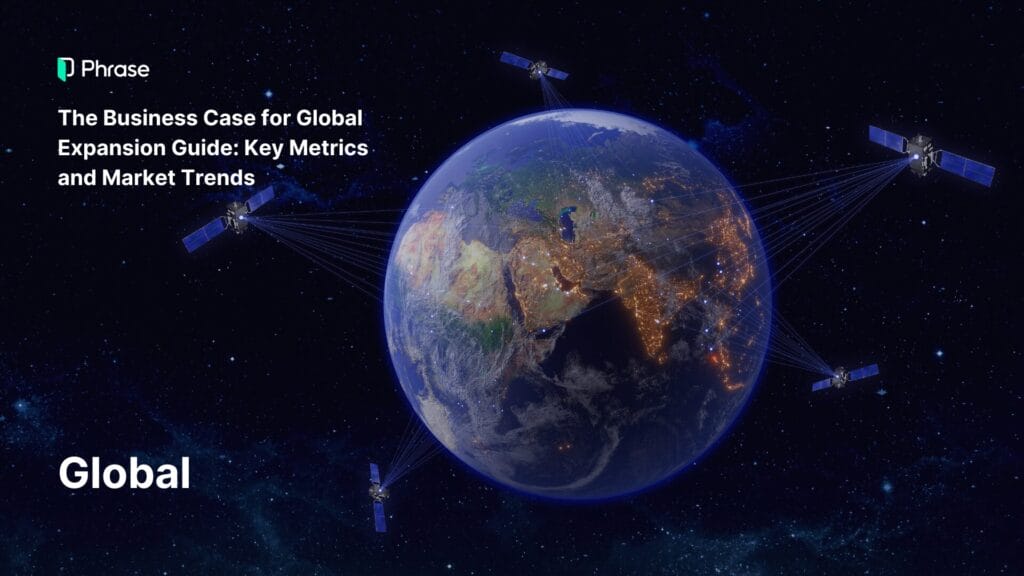
As global enterprises face increasing pressure to scale efficiently and connect meaningfully with customers across borders, data-driven decision-making has never been more critical. This global guide brings together essential insights from business leaders worldwide, revealing shared challenges and emerging opportunities in international expansion.
With 90% of companies planning to enter new-language markets within five years, and 87% confirming that localization has directly contributed to their success, the stakes are clear. Yet many still struggle—nearly two-thirds cite market entry as a challenge, and over half report losses tied to poor translation or personalization strategies.
From adapting content and navigating compliance to unlocking the power of AI and LLMs, this guide offers a high-level view of what’s driving investment and innovation across industries and regions.
Discover the full range of useful global statistics and insights
We’ve added previews from our global guide below. Download the full versions for hi-res versions of these images and more, formatted by region and sector.
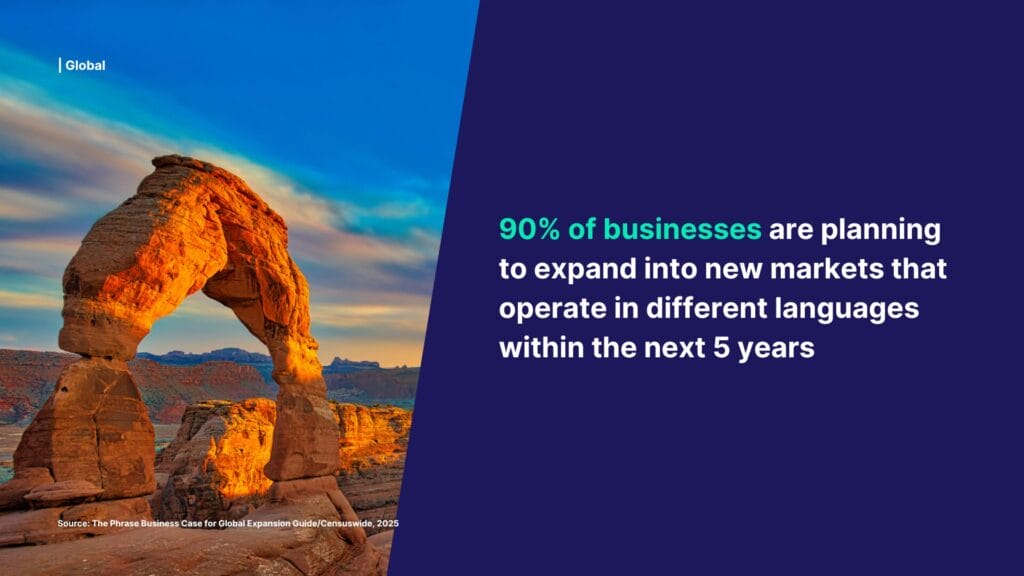
90% of businesses are planning to expand into new markets that operate in different languages within the next 5 years.

Nearly two-thirds (61%) of business leaders globally find adapting products and services a challenge in their business expansion efforts.

87% of business leaders globally confirm that investing in translation/localization has contributed to the successful expansion of their business in new markets.
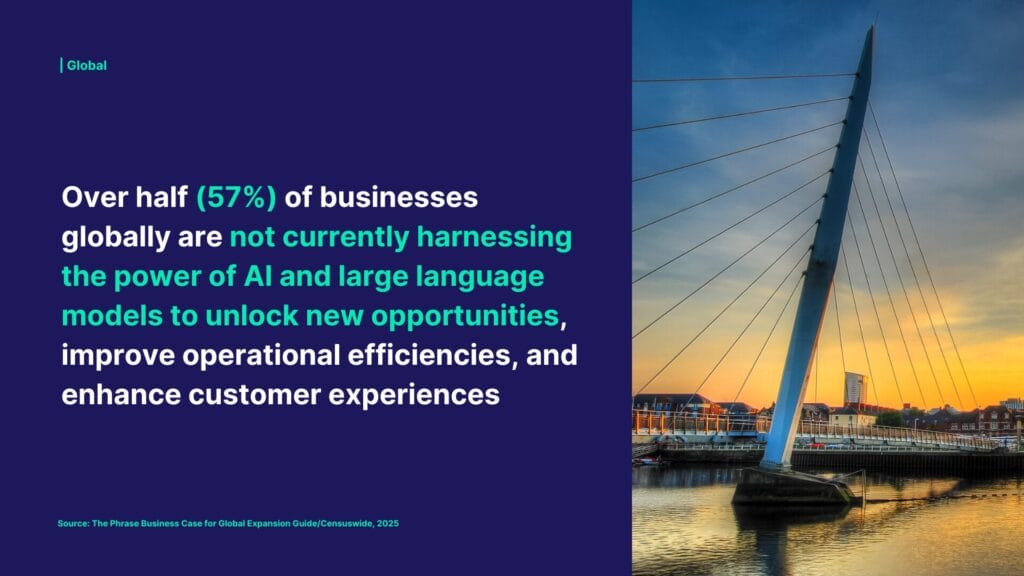
57% of businesses globally are not currently harnessing the power of AI and large language models to unlock new opportunities, improve operational efficiencies, and enhance customer experiences.
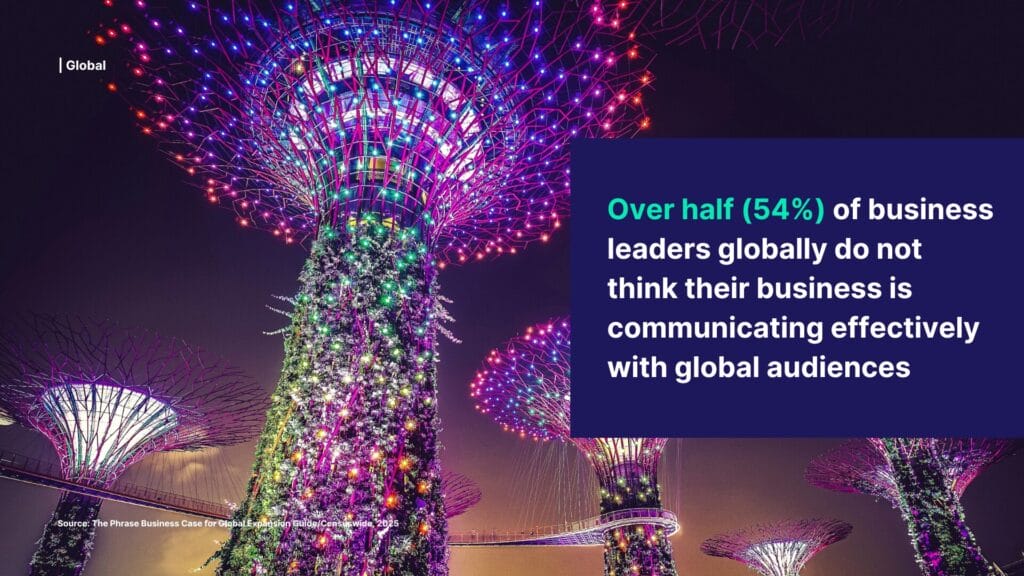
54% of business leaders globally do not think their business is communicating effectively with global audiences
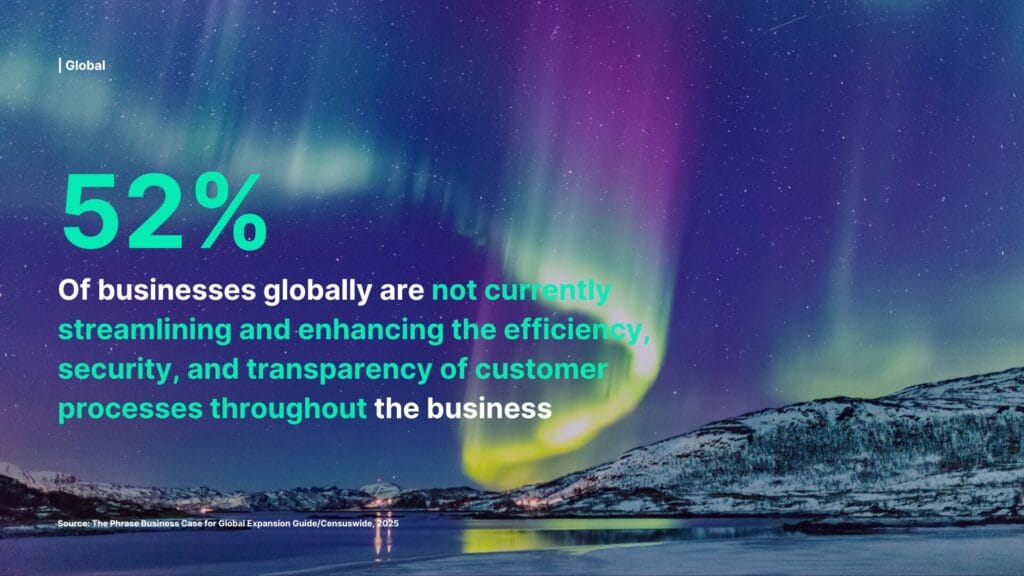
52% of businesses globally are not currently streamlining and enhancing the efficiency, security, and transparency of customer processes throughout the business.
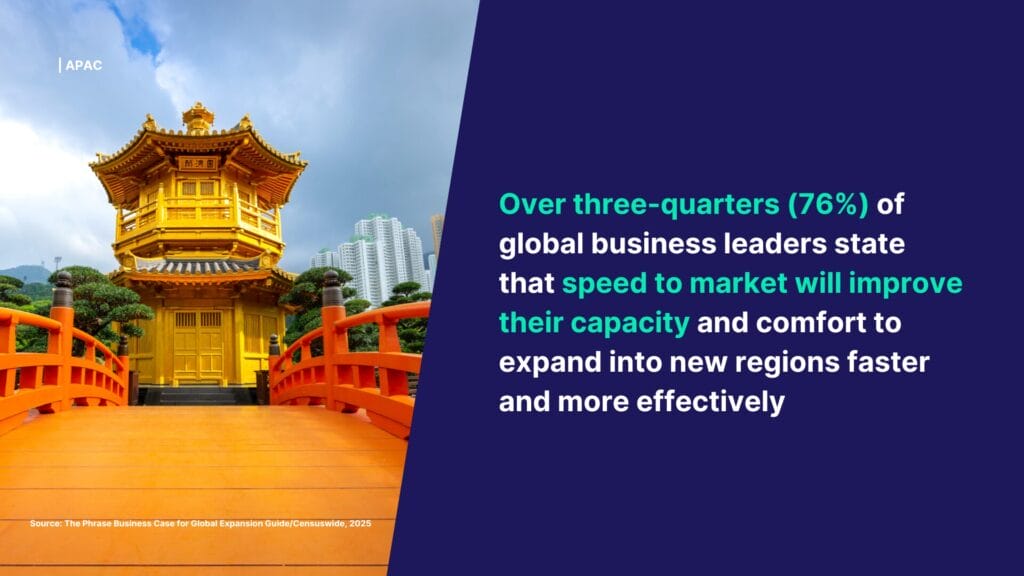
76% of global business leaders state that speed to market will improve their capacity and comfort to expand into new regions faster and more effectively.









